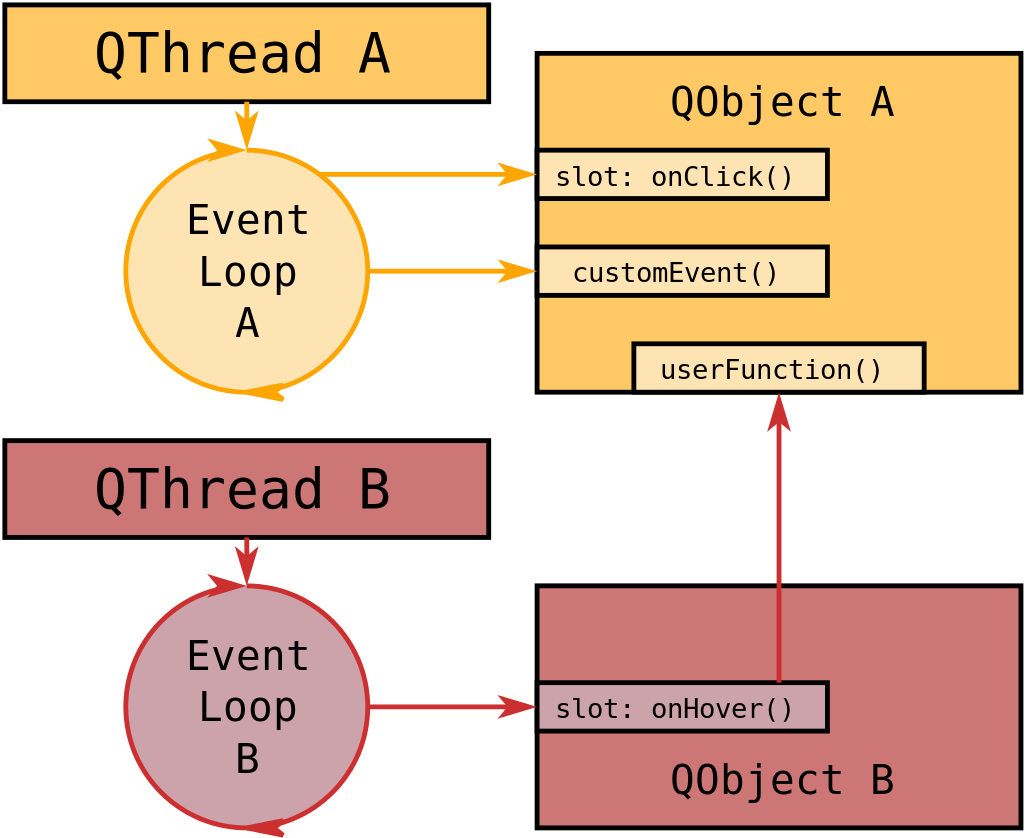Qt Slot Function Thread
Qt - Passing custom objects among threads
- Details
- Category: Programming
- Written by Nandan Banerjee
- Hits: 13044

To call a slot (or any invokablemethod) in another thread, place that call in the target thread's event loop. This lets the target thread finish its current task before the slot starts running, while the original thread continues running in parallel. To place an invocation in an event loop, make a. Signals, slots, QOBJECT, emit, SIGNAL, SLOT. Those are known as the Qt extension to C. They are in fact simple macros, defined in qobjectdefs.h. #define signals public #define slots /. nothing./ That is right, signals and slots are simple functions: the compiler will handle them them like any other functions.
A call to inmain blocks the calling thread until the Qt event loop can process our message, execute the specified method and return the result. For situations where you don’t wait to wait for the result, or you wish to do some other processing while waiting for the result, QtUtils provides the inmainlater function. This works in the same way as inmain, but returns a reference to a Python. The QThreadclass provides a platform-independent way to manage threads. A QThreadobject manages one thread of control within the program. QThreads begin executing in run. By default, run starts the event loop by calling exec and runs a Qt event loop inside the thread. SingleShot(200, this, SLOT(updateCaption)); In multithreaded applications, you can use QTimer in any thread that has an event loop. To start an event loop from a non-GUI thread, use QThread.exec. Qt uses the timer's thread affinity to determine which thread will emit the timeout signal. Because of this, you must start and stop the.
Communication between threads in a qt program is essentially done by using signals/slots. This is by far one of the most easiest and stable mode of communication amongst threads of a program.
For example, let us suppose that one thread needs to send an integer value to another thread. All the programmer needs to do is simply create a dispatch signal with two arguments, the thread id and the integer value. Thus, it can be achieved by this simple line –
Qt Signals And Slots Between Threads
Similarly, a receive slot with the same arguments needs to be created to receive the signal.
Now, this will work very nicely when one is dealing with the predefined primitive or the qt data types. This is because they are already registered and hence it is not a problem for qt to recognise those data types.
The problem arises when one wants to pass a custom data type (any class or structure that has a public default constructor, a public copy constructor, and a public destructor can be registered). Then, the user defined class or a class defined in a library not part of qt can be passed using signals/slots after registering.
The qRegisterMetaType() function is used to make the type available to non-template based functions, like the queued signal and slot connections.
This is done in the following way –
where name can be any custom data type.
For example, let us take a program which will capture the image from the webcam and display it in a QLabel on the GUI. To achieve this, two approaches can be taken. Run the camera grabbing function in the main UI thread or in a different thread and reducing the work of the UI thread significantly. If it is run in the main UI thread, then the chances of the UI thread not responding is very high. Therefore, it is always desirable make a separate thread and use it instead to run the camera grabbing function.
In this tutorial, we will use the openCV library to grab an image from the webcam and use the signal/slot mechanism to send the image (IplImage type) to the UI thread.
After creating a new qtGUI project, a new class is created (say “webcamThread”) with QThread as its parent class. A run() function is defined and a new signal with the image as the argument is defined.
Qt Signal And Slots
In the MainWindow file, a slot is defined to handle the signal from the webcamThread. This image is then converted to the QImage format and then displayed in the QLabel. So, a smooth and pleasant webcam feed can be achieved using this.
Qt code for the webcam feed -
The openCV library needs to be present in the system and the paths should be appropriately set.
// webcamthread.h
// webcamthread.cpp

Now the code for the MainWindow. The signals are connected with the slots and the event handlers are defined.
// mainwindow.h
// mainwindow.cpp
In the UI editor, two buttons (Start and Stop) and a label of size 320 by 240 need to be created. Then, just compile and run. So, it can be seen that objects of the class “IplImage” from the openCV library can be easily passed between the threads just by registering the class.